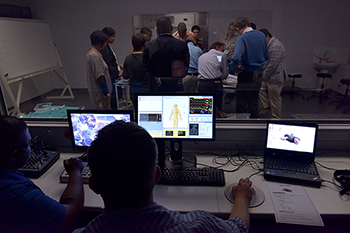
Photo: Charl Devenish |
During the past year, the School of Medicine at the University of the Free State celebrated several successes in the field of research and cooperation agreements. These successes allow the school to continue delivering world-class teaching to some of the country’s top students.
Earlier this year, a research team from the Department of Medical Microbiology under the guidance of Prof Felicity Burt, received a grant of R500 000 to conduct research on Congo fever (CCHF). Prof Burt is an internationally-recognised expert on Congo fever. The funding that has been awarded will be used to profile immune responses against CCHF viral proteins, and investigate mechanisms and strategies to enhance these immune responses. This study may contribute to the development of a vaccine against this deadly virus.
Prof Stephen Brown from the Department of Paediatrics and Child Health’s expertise and commitment to paediatric cardiology gained him the title of Bloemfonteiner of the Year. Under the leadership of Prof Brown, the department has performed many breakthrough operations and procedures. The most recent of these, was the first hybrid procedure in the country which was performed in November 2014. The department also has an ultramodern hybrid heart catheterisation suite.
Prof William Rae from the Department of Medical Physics focuses on medically-applied radiation. Together with his department, they are looking at quantitative radiation dosages. The research is particularly crucial for the successful treatment of cancers. Through this research, it is possible to ensure that patients receive the appropriate radiation dosages in order to obtain the desired effect without the patient being affected negatively.
Dr Nathanial Mofolo, Head of the Department of Family Medicine in the School of Medicine, is since 2006 involved at various levels of hospital management regarding quality assurance, patient safety, clinical and infection management, as well as administration. He is currently curator of internal medical students for four of the UFS’s teaching hospitals. His department is currently focusing on the National Health Plan, HIV and tuberculosis, teaching and learning, as well as service delivery in family medicine.
Prof Francis Smit manages the team that, to their knowledge, decellularised the first primate heart. The method has been applied successfully on rat and pig hearts by researchers in America. Recently the team also successfully cultivated beating heart cells ? those of a rat ? in their laboratories. The research is in line with what researchers in Europe and America are working on. In the long run, the research project aims to attempt ‘building’ a heart that could be used for the purposes of organ donation.
The UFS is also home to the only metabolic research unit in the country. The unit was established to focus research on obesity, type II diabetes, metabolic bone diseases and all related diseases. This includes diseases such as diabetes, cholesterol, cancer, psoriasis, lymphoedema, fatigue, high blood pressure, gout, arthritis, fibrosis, skin disorders, PMT, migraine, insomnia, gall and kidney stones and related infections, and obstructive sleep apnea. The unit is a joint initiative between the UFS and Christo Strydom Nutrition. Mr Christo Strydom, a nutritionist and world renowned in the treatment of lymphoedema, invested R5 million in the establishment of this unit at the UFS. Christo Strydom is also the founder and owner of Christo Strydom Nutrition.
The School of Medicine at the University of the Free State is the only unit on the continent offering in-depth modules in clinical simulation. The Clinical Simulation Unit on the Bloemfontein Campus of the UFS, headed by Dr Mathys Labuschagne, is regarded as the flagship unit of the school and boasts high-technology equipment where students can practice their clinical skills before applying those skills in the real world.